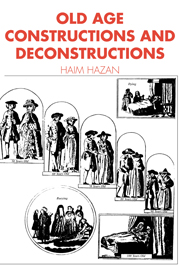Book contents
- Frontmatter
- Contents
- Acknowledgements
- Introduction: towards knowledge of old age
- PART I REPRESENTATIONS OF AGEING: LANGUAGES ABOUT OLD AGE
- 1 The social trap: the language of separation
- 2 The cultural trap: the language of images
- 3 The personal trap: the language of self-presentation
- 4 The theoretical trap: the missing language
- PART II PRESENTATIONS OF AGEING: LANGUAGES OF THE OLD
- Conclusions: the nature of knowledge about ageing
- Notes
- Bibliography
- Index
2 - The cultural trap: the language of images
Published online by Cambridge University Press: 05 June 2012
- Frontmatter
- Contents
- Acknowledgements
- Introduction: towards knowledge of old age
- PART I REPRESENTATIONS OF AGEING: LANGUAGES ABOUT OLD AGE
- 1 The social trap: the language of separation
- 2 The cultural trap: the language of images
- 3 The personal trap: the language of self-presentation
- 4 The theoretical trap: the missing language
- PART II PRESENTATIONS OF AGEING: LANGUAGES OF THE OLD
- Conclusions: the nature of knowledge about ageing
- Notes
- Bibliography
- Index
Summary
The viability of stereotypes is often held to be inversely related to the amount of concrete evidence available about their objects: the more informed we are, the less valid is the stereotype. There is, however, considerable evidence that concrete information does not necessarily invalidate a stereotype but, on the contrary, may serve to reinforce it (Alport 1959). The information received about old people is often ambiguous, and because of this the stereotype overrides our perception of them even in face-to-face interaction. Stereotypes govern our behaviour by obscuring characteristics which, to an unbiased observer, would be clearly visible. A stereotype is presumed universally applicable, without regard to interpersonal differences. It is enormously flexible and therefore useful in handling variegated and changing situations; where it seems appropriate to shift attention to the concrete information at hand, a stereotype may be temporarily set aside. Stereotypes may display contradictions both internally and among themselves. All these characteristics of stereotypes are apparent in the attribution of cultural constructs to the aged.
One of the most deeply rooted stereotypes of the aged is that they are conservative, inflexible, and resistant to change. The aged are perceived as incapable of creativity, of making progress, of starting afresh. Only in art and the domain of the spirit are they licensed to continue to be creative. ‘Ordinary’ old people are seen to have entered a state of intellectual sterility and emotional impotence.
- Type
- Chapter
- Information
- Old AgeConstructions and Deconstructions, pp. 28 - 32Publisher: Cambridge University PressPrint publication year: 1994
- 1
- Cited by



